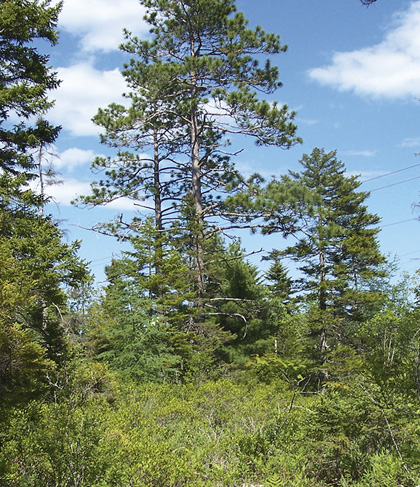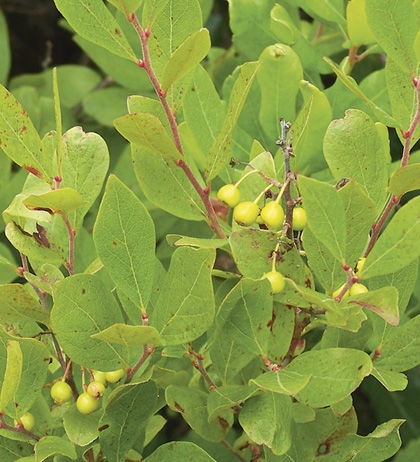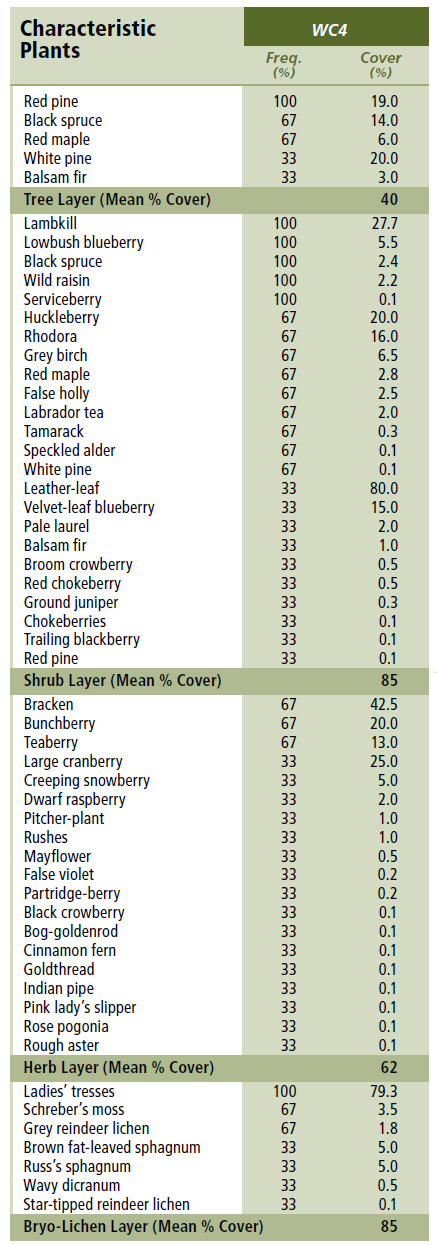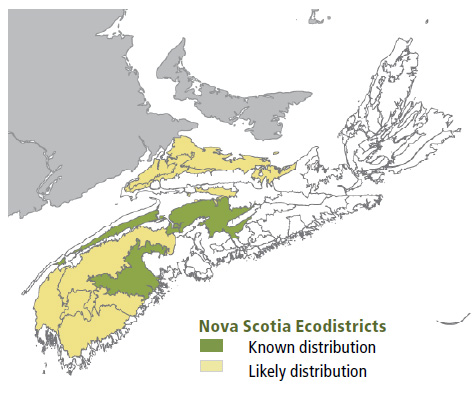
Forest Vegetation types - WC4
WC4 — Red pine – Black spruce / Huckleberry – Rhodora / Sphagnum
Pinus resinosa – Picea mariana / Gaylussacia baccata – Rhododendron canadense / Sphagnum spp.
 |
Lapland, Lunenburg County |
Concept: This uncommon wet forest is characterized by red pine canopy dominance, a well-developed shrub layer, and prominent sphagnum moss cover. The early to mid-successional ecosystem is the wettest red pine forest found in Nova Scotia. Most occurrences are initiated by (and may be maintained through) fire, but windthrow can also expose mineral soil and promote red pine recruitment.
Vegetation: Canopy layers are dominated by red pine or co-dominated by red pine and either black spruce or white pine. Crown closure is typically low but increases on less saturated soil. The understory is well developed, with moderate to high shrub and bryophyte cover. Acid tolerant shrubs including huckleberry, rhodora, low bush blueberry, wild raisin and Labrador tea, among others, are frequent. Red pine recruitment is low to absent beneath the canopy. The herb layer is reduced except in stands with prominent bracken. Bryophyte cover is well developed but species poor. Ladies' tresses is the only prominent sphagnum species.
Environmental Setting: The Red pine - Black spruce / Huckleberry - Rhodora / Sphagnum forest occurs on moderately exposed flats and gentle slopes. Soils are poorly drained glacial tills with low rooting potential and usually high organic layer accumulation. It is largely known from the Western ecoregion on moderately exposed flats and gentle slopes; microtopography is slight to moderate and aspect is variable. WC4 is somewhat rare in New Brunswick and absent from Prince Edward Island.
Successional Dynamics: This early to mid-successional forest originates with fire or windthrow, both of which may promote red pine regeneration. Tree uprooting resulting from windthrow exposes mineral soil required for red pine seed germination. Red pine's presence decreases between disturbance events. This favours black spruce, a longer-lived species with the flexibility to regenerate through either seeding or layering. In the absence of fire, the ecosystem will eventually succeed to WC2 (Black spruce / Lambkill – Labrador tea / Sphagnum).
Ecological Features: The small patch Red pine – Black spruce / Huckleberry – Rhodora / Sphagnum is an uncommon ecosystem characterized by low canopy closure but high shrub and bryophyte cover. Soils are acidic with low surface and ground water flow, reducing microhabitat variability, productivity and species richness. Reduced productivity and the presence of allelopathic plants (those that produce biochemicals that affect other plants) like lambkill can negatively influence black spruce regeneration and growth, resulting in lower canopy cover. These forests can have an older cohort of fire-scarred red pine “parent trees”, frequently with cavities and hollow trunks. Rare plants are not documented from the ecosystem and old growth potential is low. This wet forest is rare in Nova Scotia, and with its fire dependency, may present additional conservation challenges. WC4 may provide locally if not provincially unique habitat for particular wildlife, but specific associates are undocumented.
 |
| Huckleberry |
Distinguishing Features: Red pine is diagnostic of this poorly drained softwood forest with a high shrub cover, dominated by lambkill, huckleberry and rhodora. Bracken, bunchberry and teaberry are often abundant.
| Slope Position: | Level7 Middle3 |
Surface Stoniness: |
(Non - Slightly)10 |
Bedrock Outcrop: |
(Non-rocky)7 (Slightly - Moderately)3 |
Elevation Range: |
28 - 101m |
Slope Gradient: |
Level10 |
Aspect: |
West3 None7 |
Exposure: |
Moderate10 |
Microtopography: |
Level7 Moderately3 |
Drainage: |
Poor10 |
Soil Type: |
ST77 ST43 |
Parent Material: |
Glacial till7 Glaciofluvial3 |
Rooting Depth (cm): |
(<30)10 |
Duff Thickness (cm): |
(6-10)3 (11-20)3 (21-40)3 |

